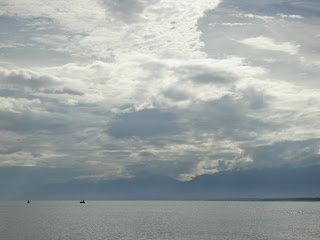Time flies! Work is rolling, friendships are blossoming and
the beautiful vistas
are leaving us jaw dropped.
And to think, in a couple of weeks we will have
completed half of our internship abroad! Adam and I are
realizing that the more we
weave ourselves into all kinds of projects, the harder it’s
going to be to leave
come March.
Our approach so far has been to take advantage of any
opportunity that comes our
way which means our weeks are flurries of activities running
from meetings to
monitorings. These past months have been taken up by
planning the big “Dia de
Campo” event which was a celebration of the reforestation
project so far. Adam
also tirelessly put together funding proposal to develop the
forest industry in
Republic Dominican; while I spent a lot of time studying web
design and planning
workshops. A goal of
ours is to ensure the continuity of the website updating
after we leave. So we have been offering computer training
workshops to local
youth to teach them how to manage a website. In a couple of
months we hope to have
trained a team of youth that will have a good foundation in
web design and will be
able to promote their own region without relying on
temporary interns.
On top of our outlined work plan, we also have been doing a
lot of networking. One
of these partnerships is helping maintain communication
between the Water Resource
PeaceCorps volunteers and ENDA. Both organizations have worked together in
the
past, so our role is to act as the intermediary to identify
opportunities for
collaboration in the upcoming projects. We are also
assisting the Incubedora de
Micro Empresas- The Incubator for Micro Enterprises in Cotui
to develop a fruit
processing plant in a nearby community and working on
various ecotourism ventures.
The concept of ecotourism is only starting to take off in
Dominican. A number of
tour operating companies, including Colinas EcoTours, are
actively working on
redefining tourism in
the country. For a country rich in biodiversity minus the
threat of any poisonous creatures; the time has come for the
Dominican tourism
industry to turn its focus on the interior. A bonus from
working in the ecotourism
sector is that we get to visit sites such as the Ruta del
Cacao, and the wetlands
near Haitillo lake! Some of these tourist destinations are
outcomes of ENDA’s
forest management initiative so we are also promoting them
via the website. In
parallel to our information gathering for the website,
CATIE, the Centro
Agronómico
Tropical de Investigación y Enseñanza – the Model Forest organization
based out of Costa
Rica, is putting a 20 year legacy
documentary together
highlighting all the Model Forest
work that has been going on around the world.
We have had the fine privilege of accompanying the film
maker to interview
involved members for the Dominican portion of the
movie.
Before the holidays start, we want to tie up loose ends and
wrap up projects. We
do look forward to some down time and getting to see more of
the country. There’s
also the highly anticipated the bachata legend, Frank Reyes,
whose concert next
door at the De Melissa Car Wash has been marked in our
calendar for weeks now!
It’s safe to say that yes in fact, we’ve caught the
Dominican Latin Fever.
Saludos,
Elisa & Adam
 |
| Adam with his vegetation sampling partner. |
 |
Sr. Ferreira showing off healthy seedlings. |
 |
Tree nursery for reforestation project. |






























